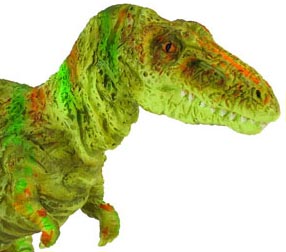Tarbosaurus bataar Case – Florida Man Pleads Guilty
Guilty Plea in Dinosaur Smuggling Case
A Florida resident, at the centre of a dinosaur skeleton row has pleaded guilty to charges regarding the making of false statements on customs forms. He is due to face sentencing in the spring of 2013.
The federal court case centred around the auction of an eight-metre-long, mounted skeleton exhibit of a theropod dinosaur known as Tarbosaurus (Tarbosaurus bataar). The auction took place at Heritage Auctions in New York on Sunday May 20th of this year, despite a number of palaeontologists and other lobby groups attempting to block the sale. The lot was sold for approximately £630,000 GBP (over $1 million USD), a little more than the estimated value. The skeleton, which represents a sub-adult dinosaur and is believed to be around seventy-five percent complete was purchased by an unnamed individual.
To read an article about the seizure of the dinosaur fossil: The Seizing of a Tyrannosaur.
Tarbosaurus bataar
Tarbosaurus is a member of the tyrannosaurid dinosaur family. It was a large, apex predator that roamed Mongolia around seventy million years ago in the Late Cretaceous (Maastrichtian faunal stage). First named and described back in 1955 by the Russian palaeontologist Evgeny Aleksandrovich Maleev.
Tarbosaurus is closely related to the most famous dinosaur of all – Tyrannosaurus rex. Maleev did not that the Mongolian dinosaur was very similar to the North American T. rex, they shared a number of common anatomical features (autapomorphies). For a time, this dinosaur was known as Tyrannosaurus bataar, but in the mid 1960s following a review of the fossil material from both tyrannosaurid species, the name Tarbosaurus was established for this genus. The name Tarbosaurus means “alarming reptile” and with a maximum length in excess of twelve metres and weighing perhaps as much as five tonnes, this theropod dinosaur was a formidable predator.
An Illustration of Tarbosaurus (Tarbosaurus bataar)
Picture credit: Everything Dinosaur
The picture (above) shows a Tarbosaurus figure from the CollectA model range.
To view this range: Tyrannosaur Models and Prehistoric Animals (CollectA).
For the New York auction, the mounted specimen was described as Tyrannosaurus bataar. Cynics might state that this term was used to help make the lot more valuable and to fetch a higher prices as Tyrannosaurus would have had a wider commercial appeal than the relatively less known Tarbosaurus. However, the specimen, if it did come from Mongolia would pose a problem for the seller as it has been illegal to remove from Mongolia fossils or any other artefacts of “cultural significance” for more than fifty years. This law had been in place even before the formal scientific description and review of the fossil material associated with of Tarbosaurus.
A number of interested parties tried to intervene, either to stop the auction or to have the lot impounded until the provenance of the fossil could be established. The Mongolian President, Elbegdorj Tsakhia became involved, insisting that this fossil was the property of the Mongolian people and that it had been illegally smuggled out of his country.
At a federal court hearing yesterday, thirty-eight year old Eric Prokopi from the town of Gainesville, Florida (United States), pleaded guilty to making “vague and misleading” statements concerning the importing of the crates containing the dinosaur fossils into America. The plea covers the statements made on the U.S. customs paperwork provided in connection with the import of the Tarbosaurus fossil material, allegedly smuggled out of Mongolia.
The Tarbosaurus exhibit was examined by leading palaeontologists after the auction, when the lot had been seized by federal agents. They declared that the fossil material had, most likely, originated in Mongolia and therefore the fossils had been obtained illegally. Mr Prokopi, had tried to claim back the Tarbosaurus skeleton in October. He claimed that he imported a set of jumbled bones and it was his skill at preparing the fossils and making them into a single specimen that had added the value to the dinosaur exhibit.
In what is believed to be a plea bargain, Mr Prokopi pleaded guilty to the charges of conspiracy to make false statements on customs forms, misrepresenting imported goods and the interstate transport of stolen property. The plea bargain may have been part of an agreement reached between the parties involved as Mr Prokopi had been accused of importing (allegedly, a number of other dinosaur fossils from Mongolia, including fossils of the duck-billed dinosaur Saurolophus and an oviraptorid. The Tarbosaurus specimen may have been just one of a number of illegal transactions concerning dinosaur fossils carried out.
People pleading guilty to such charges can find themselves facing up to ten years in prison. Sentencing is set for 25th April, just under a year after the Tarbosaurus auction in New York.
A number of governments and other national authorities have promised to clamp down on the huge, black market for fossils, especially dinosaur fossils. Individual specimens, such as this Tarbosaurus can sell for enormous sums of money and although no official figures are available, customs officials state the smuggling and illegal sale of such items is very widespread.


